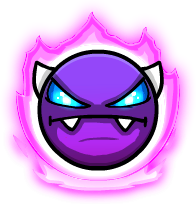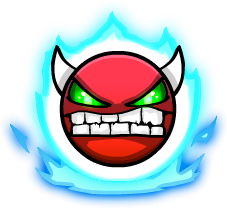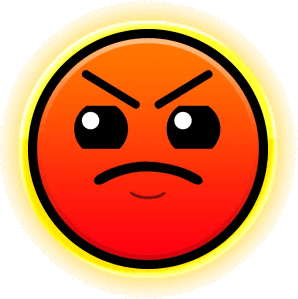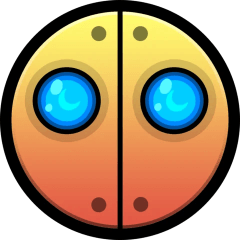Junior Member
Rating Curve
Filters
Reviews
It's a shame the song for this level is gone, because it was insanely hype for its time and the level represents it really well. This level is basically everything people love about dorabaebasic7 but with tons more energy. The visuals are barebones but it plays great and I'll always love it for that.
ARGIBI is yet another example of a platformer level that feels too good for Geometry Dash. The entire level centers around the color-shifting gimmick lifted from the Flash game Primary, but directly acknowledges this rather than trying to sell it as an original idea. This mechanic seems misleadingly simple at first, but is constantly expanded on throughout the level in exceptionally creative ways.
That being said, my biggest problem with this level is actually what it chooses to lift from the source material. I played through Primary after my initial completion of the level (again, props to 7rodo for encouraging players to check it out!), and felt as if the level design was mostly carried by the blue color. The other abilities (invincibility and fire) have nowhere near as many interesting interactions, compared to the ice block which consistently led to satisfying puzzles and level design. ARGIBI, of course, uses these exact same abilities, and certain sections of the level (e.g. the part where you can no longer shift colors, and the ending escape sequence) really highlight just how little the green/red modes have going for them. I believe this was a heavily missed opportunity for more interesting powers, that could maybe mix in vanilla GD mechanics such as gravity changes or teleportation.
Fortunately, the rest of this level absolutely slaps. The overall gameplay and progression is extremely smooth, and I never really felt like the level was reusing too many ideas. The visual style is super clean, prioritizing gameplay clarity while still leaving plenty of room for environmental storytelling. It's far more detailed than the visuals in Primary (and the other inspiration, Nitrome Must Die) and isn't afraid to do its own thing. In particular, I love how much the "rot" contrasts the otherwise bright and modern-feeling environment. It makes the player feel uneasy while also clearly highlighting dangerous gameplay elements.
I also really enjoyed the two boss fights in this level (optional one included). They were definitely on the easier side, but I usually prefer that since I play these levels for the platforming aspect and not the fighting. The CEO fight in particular had a ton of personality and super fun attack patterns, and overall checked every box for me. It could be argued that the boss fights should force you to shift colors more often, but I think that would have been overwhelming so I'm fine with simply using them for toggling platforms.
All in all, ARGIBI is extremely well executed and very fun to play through. The entire setting for the level feels super alive, and the interactions with the CEO genuinely made me smile. Normally I'd compliment a level of this quality by saying that it could stand as its own game, but in this case I think its defining mechanic is too blatantly similar to Primary. For a Geometry Dash level, though, it's perfectly fine and I'd say the Legendary rating is well deserved.
Dead God Cult is, in my opinion, the pinnacle of Geometry Dash being used as a game engine. It's a fully original deck-builder roguelike complete with multiple game modes and an original soundtrack composed by the creator. Despite being built in the GD editor, the entire thing is extremely polished with no noticeable bugs or cut corners. The art and effects are gorgeous, and they all come together to form a super relaxed but engaging visual style. As far as I can tell, the core gameplay loop is fully original, though it clearly takes inspiration from other deck-builders such as Balatro and Inscryption.
I won't describe all the mechanics of Dead God Cult in this review, but essentially it revolves around strategically playing your cards in order to reach each round's score threshold. Each card has a wildly different effect, so you need to build your deck wisely and balance scoring points with earning 'faith' to play even more cards. All the cards come with gorgeous visuals, and often synergize with many of the other ones in the game. Cards are also very fairly balanced, with stronger effects costing more to play or requiring specific conditions to be met (e.g. play this card last).
After each round, you add a new card to your deck and earn some 'belief' that can be spent on permanent upgrades (such as staring rounds with more cards or faith). Individual cards can also be upgraded multiple times, and the system for it is masterfully done. Pretty much every card upgrades and scales in a different way, and a lot of the game's strategy centers around knowing which ones you should focus on. I love the choice to only let you choose between 3 of your cards, as it prevents going 'all in' on one card while still making you feel very in control. Additionally, the ability to spent belief on destroying cards from your deck is a fantastic addition to the game, as it allows for riskier 'thin-to-win' strategies which are common across the genre.
In my opinion, the game gets most interesting once you reach the later rounds. I'm still a bit mixed on if the balancing is fair or not, as even with seemingly great decks, I've lost a lot of runs to being dealt bad hands. However, that's pretty normal across deck-builder games and it encourages you to reconsider how you plan your deck in the next run. I will say that runs of this game have a bit less variety compared to something like Balatro or Slay the Spire, but you're still presented with many opportunities to try different play styles. If you feel ilke you have a powerful deck, you can choose to play a "hard" round with double the score requirement in order to earn better rewards. This is perhaps my favorite design decision in the entire game - it's an incredibly tempting risk/reward system that requires full confidence in the deck you've constructed.
My biggest complaint with Dead God Cult is simply the fact that it's not a standalone game. The GD editor allows you to make pretty much anything you could imagine, but it comes at the cost of a very limited control scheme. I had no trouble getting used to them, but I still would have preferred to play a game like this with a mouse. I sincerely hope that Dead God Cult gets expanded into a full game outside of GD, since it's a genuinely fantastic work that I keep coming back to. Some of the best indie games of all time have started as simple prototypes (Celeste, Baba is You, Inscryption, etc), and I truly hope that this level marks the start of another massive indie success story. Not only was Soverney able to design a phenomenal game in an unconventional engine, but they also clearly demonstrated that they can make amazing visuals and music for it as well. The Mythic rating is more than deserved and I continue to be so happy that Geometry Dash has given people a platform to build the games they're always wanted to make.
Generation Retro is without a doubt one of the most infamous levels in Geometry Dash. Many players nowadays see it as an abomination, and the fact that it's "officialized" in the Poison Gauntlet only rubs salt in the wound. The level receives nonstop hate comments from angry players, and is overall the butt of many jokes across the community (which I may or may not be partially responsible for...). But as someone who thinks about Generation Retro far more than any normal human being, I've grown to realize that there's lots that goes unappreciated. As much as I love to joke about the level, I actually see it as a passion project that unfortunately got ruined by its placement in a Gauntlet - something that ArathhSA had no control over. I see lots of hate directed towards him for making this level, but I've always considered RobTop to be the one at fault for forcing players to beat something this unpolished.
I could probably spend around 28 minutes talking about why this level plays so terribly, but that would be like explaining how water is wet. Most early 2.0 levels had a huge tank in gameplay quality compared to 1.9, and no doubt it's because creators were eager to shoehorn in all the new features that were yet to have proper gameplay standards. The level has invisible size/speed portals, sudden moving objects, unconventional gimmicks, and an infuriatingly unfair boss fight that boils down to memorization. Most of the 2.0 features do more harm than good, and it makes for a pretty miserable gameplay experience. It's clear that the level was not tested, and that playability was far from ArathhSA's top priority. It's also worth noting that boss fights were very new to Update 2.0, and it would take a lot of time for creators to understand how to make them "work". So while the fight in Generation Retro is a bit of a mess, it was certainly novel for the time considering how few bosses there were to use as a reference.
What makes Generation Retro so iconic is, of course, its theming. Many 1.9 levels played around with the green retro arcade aesthetic in the past, but Update 2.0 allowed this level to take it a huge step further. This time, there could be moving objects, animated Space Invaders aliens, cutscenes and dialogue throughout the level, and once again, a boss fight to top it all off. You could tell that ArathhSA really tried to make this level something special, but unfortunately it missed the mark. The decoration is bland and repetitive, the music sync is minimal, and the level relies too heavily on (likely stolen) pixel art that's copy/pasted throughout the entire thing. Not to mention the cutscenes, which have horrible pacing and hilariously broken English.
But while Generation Retro is terrible in execution, it's still clearly filled with so much passion. You can tell that ArathhSA was extremely excited about this level, and took a lot of pride in it. Because even if the level is pretty subpar in reality, it makes up for it in creativity. While most GD levels are about avoiding arbitrary obstacles and rushing to the goal, Generation Retro can be seen as an interactive story that uses Geometry Dash as its medium to tell it. Before the level was popularized by the Poison Gauntlet, it was actually very well-recieved because players understood ArathhSA's vision. RobTop himself even commended the level on Twitter, and it resonated enough for him to want to include it in a Gauntlet nearly a year and a half after its release.
At the end of the day, Generation Retro is an objectively terrible level IF you're simply playing it to beat the Poison Gauntlet. And that's because there's almost nothing physically in the level that makes it good. Nowdays it highlights everything wrong with early 2.0 levels, but back then it revealed all the potential that came with the update. To truly appreciate Generation Retro, one must step back and view it as a form of creative expression. ArathhSA never cared about rate standards or making the best level possible - he just had a cool idea that he was excited about. The level may be terribly put together, but he still had the balls to turn his unique vision into a Geometry Dash level and hit upload. And for that, he's earned my respect.
This level was really great for its time, but the more I watch it the more I notice just how much it's engineered to make you as emotional as possible. I'm not sure if that's a good or bad thing, but it makes the story extremely one dimensional once you see past that.
GDPR Cookie Consent
Hyperbolus uses cookies and local browser storage to enable basic functionality of the site. If we make any changes to these options we will ask for your consent again.
sorry about this gang




